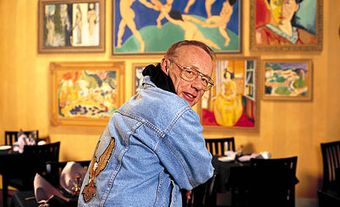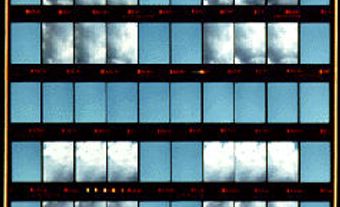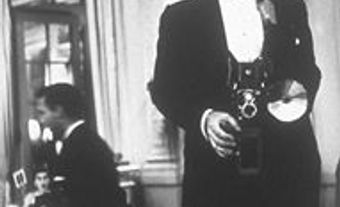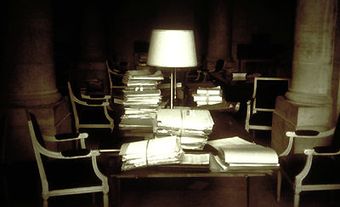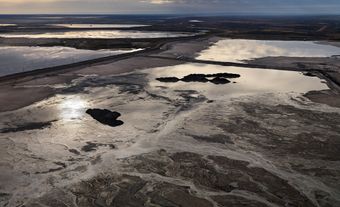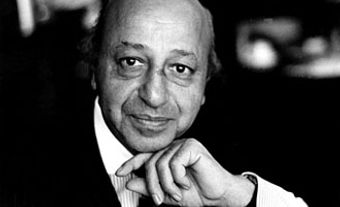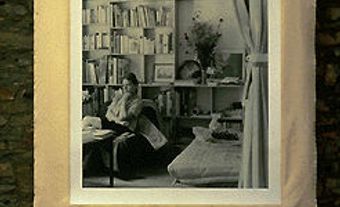
Photography
In 1839, 2 photographic processes were announced. In France, Louis Jacques Mandé Daguerre, assisted by the research of Nicephore Niepce, succeeded in securing a unique image on a silver-plated copper plate; the daguerreotype was referred to as "a mirror with a memory." At the same time in England, William Henry Fox Talbot developed a negative/positive process on paper; the negative was identified as a "calotype," the positive, as a "salted paper print."
Both processes had distinct characteristics: the daguerreotype delineated each subject in minute detail; there was optical democracy. But the salted paper print emphasized broad masses and soft focus. Contact printing through a paper negative obscured detail and definition.

Daguerreotype and Calotype
Through the 19th-century press network and individual couriers, the daguerreotype and the calotype became known around the world, although initially the daguerreotype enjoyed greater success since it was not restricted by patent except in England. News of the remarkable discoveries reached the Canadian public in the spring of 1839. The Quebec Gazette, the Toronto Patriot and the Halifax Colonial Pearl reported on the daguerreotype and on Talbot's "new art of sun painting." Itinerant daguerreotypists set up studios in suitable hotel rooms or stores with skylights and produced likenesses of their clients, or "patients" as they were sometimes called. The task was arduous: long exposure times, bad weather, erratic temperatures and difficult working conditions contributed to the low success rate of the early photographers. Few identified images have survived.
Records in Canadian journals identify 2 Americans, Halsey and Sadd, who set up studios in Montréal and Québec late in 1840 and a Mrs Fletcher in Montréal in 1841, probably the first woman photographer in Canada. Thomas Coffin Doane was one of the few successful daguerreotypists in Montréal. He visited Newfoundland in 1843 with his partner William Valentine and secured some portraits, but he is best known for his daguerreotypes of Lord Elgin and family and of Louis-Joseph Papineau. He also received an honourable mention award at the Paris Exhibition of 1855, along with Eli J. Palmer. In Toronto, where Palmer worked, several studios flourished for short periods of time, but their output is now lost. However, from 1847 until about 1870 Palmer produced daguerreotypes and the popular cartes de visite, small photographic images glued to stiff cardboard and used as calling cards or bound in photo albums for future generations.

The Wet Collodion Process
The original carte de visite was popularized in France by André Adolphe Disdéri, who photographed Napoleon III in 1859 and mass-produced the image on small cards. Prominent leaders and the rising middle class rushed to portrait studios. Duplication was greatly improved by the introduction of the wet collodion process, developed by an Englishman, F. Scott Archer, in 1851. The procedure gave a clear negative on glass and, by contact printing, a finely delineated positive, the albumen print. Like Talbot's process, it had the potential of unlimited copies, yet it retained an admirable clarity of detail.
The wet collodion process improved speed and reproduction, but by modern standards it was difficult. The operator had to coat the plate, then expose and develop it before the emulsion had dried and lost sensitivity. Nevertheless, in the 19th century it facilitated photographic activity. In 1851 Lovell's Canadian Directory cited only 11 daguerreotypists; by 1865 the Canada Classified Directory listed more than 360 photographers.
The most famous was William Notman, who exercised his influence in Halifax, Saint John, Montréal, Ottawa, Toronto and in the US. In 1858 he documented the construction of the Victoria Bridge in Montréal, the longest tubular bridge in the world at the time. Conscious of history and the importance of the ceremony, in 1860 he recorded the royal visit of the Prince of Wales to inaugurate the bridge and was appointed photographer to the Queen. With a growing reputation, he was able to attract an extensive clientele and his business expanded. By the 1870s Notman, his sons and a large staff turned out 14 000 negatives each year.
Notman also excelled in composite photographs, where each image was made from several individual pictures, cut out, pasted onto a painting and rephotographed. An ambitious montage of the Skating Carnival in 1869 was made from about 300 single photos. Pioneering the use of the magnesium flare in Canada, he also recreated many elaborate indigenous scenes in his Montréal studios.
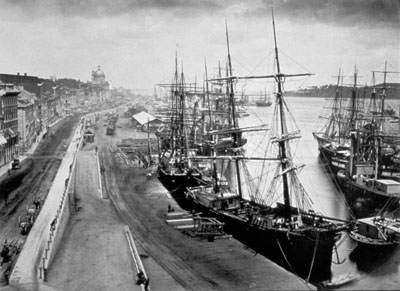
At the same time in Québec City, the studio of Ellison and Co produced elegant portraits notable for their simplicity, directness and power. They dispensed with extravagant studio backdrops but used conventional props such as columns and drapery to distinguish the setting. Their oeuvre included portraits, cartes de visite and cabinet cards of Québec dignitaries. Cabinet cards were a larger version of the cartes de visite and were collected with enthusiasm from 1868 until WWI.
Albums of views and stereographs were also popular in the 19th-century. Stereos were the 19th-century equivalent of the television. "No home without a stereoscope" was the claim of the London Stereoscopic Co, and images from around the world graced the drawing rooms of the middle class. The apparatus for the production of a stereographic image was a camera with 2 lenses separated by the same distance as human eyes. It produced 2 nearly identical images which, when looked at through a stereo-viewer, gave the impression of the third dimension.
As in the albums of mounted photographs, landscapes and architectural subjects were frequently portrayed in stereographs. One of the first photographers to publish a series of mounted photos was Samuel McLaughlin who, in 1858-60, produced The Photographic Portfolio, views of Québec and the surrounding area. His best-known image is The Ice Boat, a scene on the St Lawrence framed by the Québec Citadel. In 1861 he became the official government photographer, commissioned to photograph the construction of the Parliament Buildings. In keeping with the grandeur of the project, McLaughlin used mammoth plates, sometimes as large as 27´ x 36´. Despite the unwieldy wet collodion process, he succeeded in producing 24 negatives of various sizes in 1861.
Another photographer, Alexander Henderson, is distinguished for his work published in Canadian Views and Studies, Photographed from Nature, a series of albums which appeared in the mid-1860s. His photographs are characterized by a sense of space particular to the Canadian landscape and a sense of time and season.
Meet C. D. Hoy of Quesnel, B.C. His work wasn't discovered until 1995 when archivists found his photography. He left behind thousands of pictures that offered a rare look at life during the turn of the century through the eyes of the marginalized.
Note: The Secret Life of Canada is hosted and written by Falen Johnson and Leah Simone Bowen and is a CBC original podcast independent of The Canadian Encyclopedia.
Photography Moves West
Initial photographic activity was restricted to the settlements in Upper and Lower Canada. In the 1850s the westward trek began, stimulated by the discovery of gold in BC, by an effort to protect isolated communities from American expansion, and by government interest in trade and commerce. The efforts of 19th-century photographers to record the land and overcome the difficulties of an unfriendly environment were heroic and stubborn.
One of the first was Humphrey Lloyd HIME, who accompanied the government Assiniboine and Saskatchewan Exploring Expedition to survey the West for future settlement and exploration. His photographs of prairie topography, published in The London Illustrated News, are stark in their simplicity and economical in their vision. In 1871 Benjamin Baltzly, a Notman employee, accompanied the Geological Survey of Canada party led by Alfred Selwyn to determine a route for the extension of the CPR, thereby encouraging British Columbia to join Confederation.
With the opening of BC, the pioneering spirit of some photographers took hold and was fired by the gold rush of the 1850s and 1860s - prime photographic material. Charles Gentile accumulated historically important photos of the Leech River gold flurry in 1864. The Englishman Frederick Dally photographed the Cariboo goldfields and Barkerville, a boom town. According to newspaper reports, he did "wonderful face work" - presumably portraits.
Another Englishman, George Robinson Fardon, documented Vancouver I; his photographs and his panoramic views of Victoria, composed of several small prints carefully matched to give the impression of a panorama, were exhibited at the International Exhibition in London in 1862. Francis G. Claudet, son of the celebrated French daguerreotypist Antoine Claudet, arrived in 1859 as chief assayer for BC. He produced at least 2 albums of photographic views, though authorship of some images is disputed. Photographers often bought or accumulated photos and published them under their own name, thereby making the task of identification difficult.
Some of the plates taken by Dally were eventually acquired by Richard and Hannah Maynard, 2 of the most successful photographers in BC. In 1862 Hannah Maynard established a portrait studio in Victoria; Richard Maynard learned the trade from her and was responsible for a number of views of the province in the 1870s and 1880s.

Technical Improvements of the Late 19th Century
By the late 1870s the mass-produced gelatine dry plate was in common use and photographers no longer suffered the trials of preparing their own plates on the spot. Dry plates became standard material on government survey expeditions, including a British expedition to reach the North Pole. Through blinding snowstorms this team managed to travel to the farthest point ever reached by an expedition, and 2 members, Thomas Mitchell and George White, secured more than 100 plates, at least one at -45°C.
With technical improvements, instantaneous photography became possible. Previous attempts to photograph events in motion were extremely difficult, given the bulky equipment, imperfect lenses and slow exposure speeds. But 2 extant views are remarkable for their instantaneity: a photograph taken by James Inglis at Thomas d'Arcy McGee's funeral procession in Montréal in 1868, and an anonymous photograph taken at the Feu de joie in front of the Parliament Buildings the same year. In 1885 Capt James Peters photographed the North-West Rebellion; using a camera equipped with a magazine to facilitate changing plates after each exposure, Peters managed to get some pictures during the battle.
In 1888 George Eastman invented the hand camera and Kodak became an immediate success. The camera was loaded with film capable of 100 exposures. Once the film had been exposed, the camera with the film still inside was returned to Kodak. The film was removed, processed, positive prints made, a new roll of film put into the camera and the whole thing returned to the sender. "You press the button, we do the rest" was a believable slogan.
As the number of amateur photographers increased rapidly, photo clubs were formed which in turn produced some distinguished photographers. The Toronto Amateur Photographic Assn was organized in 1888 and, as the Toronto Camera Club, began to hold exhibitions by 1891. In 1905 Sidney Carter, an associate member of Photo Secession, founded the Toronto Studio Club, designed after England's Linked Ring, which for one year espoused the virtues of the overtly manipulated image.
Photography had been criticized as a mechanical medium which ignored the intervention of the photographer. In an effort to give visual evidence of the nonmechanical hand of man, many advocates of the manipulated image appeared. Simultaneously, there were the champions of the straight, unretouched image as a true manifestation of the medium. The dichotomy between pictorialism or manipulated image and purism or straight photography echoed the difference between the calotype and daguerreotype.
Diverse processes were used by pictorialist photographers to achieve their objectives: gum bichromate, cyanotype and bromoil transfer all allowed the gesture of the brush stroke to show as the emulsion was applied to a paper support. In a less obvious manner, without resorting to alternative processes, photographers also used soft focus lenses or threw the image out of focus to obtain tone and an ethereal atmosphere rather than finely delineated details. In the first decades of the 20th century, Harold Mortimer-Lamb, a British engineer who had a close association with Carter and the Toronto Camera Club, and John Vanderpant, a Dutchman who settled in Vancouver, produced romantic soft-focus portraits and concentrated on the effects of light and shadow, mass and tone.

By the 1930s, Vanderpant's style was changing and he began to investigate the potential of straight photography. He exhibited widely in international salons and achieved recognition from photographers in the US. In 1926 Vanderpant and Mortimer-Lamb opened a gallery together, featuring a studio, art and antique galleries. The association was short-lived, but the gallery continued and occasionally served as a showcase for members of the Group of Seven.
In 1934 the National Gallery of Canada inaugurated the first annual Canadian International Salon of Photographic Art, this event marked the beginning of its involvement with the medium. Until the outset of WWII the gallery organized travelling exhibits. The Canadian Government Motion Picture Bureau had a still-photo division shortly after WWI, a tradition continued by its successor, the National Film Board, founded in 1939. Initially, this sector was set up to provide visual material for various government departments, and it later expanded into a photo bank for newspapers and journals across the country. An active editorial group supplied weekly photo stories to Canadian and foreign publications.
Photographic Journalism
With the government's recognition of the value of documentary photography, photojournalism flourished in Canada. William James and Arthur Goss were both active before 1914 and produced significant collections. One of the first sustained efforts to document military events occurred during WWI. The Canadian War Records Office was established in 1916 by Max Aitken (Lord Beaverbrook). One of its tasks was to secure photographs from the front in order to obtain a permanent and vivid impression of what was happening. Englishman William Ivor Castle was appointed official Canadian photographer and went to France in 1916; he made a 2-year tour of Canada and the US with some of the first photographs to be widely circulated. Photos of men scrambling over the top of the trenches were acclaimed as accurate portrayals of men at war. In fact, it appears they were taken during combat training or staged far from the front line and later cropped to eliminate any unwarlike paraphernalia. Other more instantaneous photos were taken at major battles involving Canadians from 1917 until the end of the war by William Rider-Rider, another Englishman appointed by the War Records Office.

The rise of the picture magazine also provided an outlet for photojournalists. The Montréal Standard and the Winnipeg New World were the first to commission the photo essay in the 1940s. A Montréal Standard photographer, Henri Paul, a Frenchman living in Montréal, was well known for his coverage of the Théâtre du Nouveau Monde; he was one of the first photographers in Canada to use the 35 mm camera, well suited to the needs of reportage. Weekend took over from the Montréal Standard in the 1950s and became a national magazine in competition with the Toronto Star Weekly. Between them they hired photographers Kryn Taconis, John Reeves, John deVisser, Lutz Dille, Michel Lambeth, Walter Curtim, Chris Lund, John Max and Yousuf Karsh. Karsh, a well-known and popular portrait photographer, established a studio in Ottawa in 1932; using dramatic studio lighting and classical poses, he photographed many contemporary leaders and celebrities.
Galleries and Publications
A dramatic increase in photographic activity occurred in the late 1960s. The National Film Board began a publishing program and established a photo gallery in Ottawa. It collected work from contemporary Canadian photographers, organized travelling exhibitions and prepared support material such as catalogues and slide-tape shows. In 1985 the Canadian Museum of Contemporary Photography was established to carry on the mandate of the Film Board photo collection and exhibition program but its affiliation shifted from the board to the National Gallery of Canada. In 1967 James Borcoman, curator of photography at the National Gallery, began an international photo collection, particularly of historical works. The National Archives of Canada houses a collection of Canadian documentary photographs from the mid-19th century to the present. These 3 government institutions attempt to provide an overview of national and international photographic representation, without overlap or competition.
Photography has yet to be accepted by galleries and museums as equal to other art forms. Only the National Gallery and the Winnipeg Art Gallery employ full-time curators of photography and are accorded funds for the acquisition of photos. Individual exhibitions arranged by guest curators, however, have been well received by the public in many cities. Since 1973 the Canada Council has provided program and operating funds to several artist-run spaces specializing in photography; grants are also made available to individual photographers and to galleries for particular exhibitions.
In 1967 a group of photographers began the monthly bilingual magazine Foto Canada, which was printed in gravure and reflected a high standard of photography in Canada. Unfortunately, financial support for the magazine waned after a year and it ceased publication.
During the 1970s photographic publications exhibited various attitudes towards the medium; Impressions, Image Nation and Impulse presented contemporary, sometimes offbeat photographic work. The Montréal magazine OVO promoted photography as a means of communication and social change; Photo Communiqué attempted to provide an information exchange among members of the photographic community and a critical analysis of historical and contemporary work.
More recently, a plethora of photographic exhibition catalogues has emerged from museums and artist-run centres like Montréal's Dazibao, which exhibits only photography, and articles on photography have become a regular feature of art magazines such as Parachute and Canadian Art.
In the 1970s Canada, along with the US and Europe, experienced an upsurge of interest in "art" photography, and saw the opening of commercial galleries devoted exclusively to photographic imagery, including Yajima Gallery in Montréal and Nova Gallery in Vancouver, the former showing the street photographs of Charles Gagnon, Tom Gibson and Gabor Szilasi, Lynne Cohen's documents of contemporary interiors, and the landscape images of Geoffrey James; the latter exhibiting the large-scale colour works of internationally recognized photo-artist Jeff Wall, whose visual vocabulary was appropriated from both media advertising and art history.

The Saskatoon Photographer's Gallery initiated a co-operatively-run exhibition space and workshop which has continued to the present as an important centre for photographic activity in Western Canada. Early shows included the autobiographical narrative
works of Sandra Semchuk. Galerie Ville in Québec City and the Toronto Photographer's Workshop also provide venues for the exhibition of current photographic production. Compendiums of Canadian photography have included the "Banff Purchase" published
in 1979 by the Banff Centre for Continuing Education, the National Film Board Stills Division's "1984 Canadian Contemporary Photography,"
and the landmark "Montréal au XXe siècle: Regards de photographes" edited by Michel Lessard.
In 1985 the Canadian Museum of Contemporary Photography was established in Ottawa to carry on the mandate of the Stills Division of the National Film Board. "Mois de la Photo," a biannual, city-wide series of exhibitions and national and international photographic works, was initiated by the Montréal group Vox Populi in 1989. Montréal's CV Photo magazine highlights Canadian and particularly Québec contemporary photography.
Art departments, including those at Concordia University, the University of Ottawa, and the Nova Scotia College of Art and Design, began in the 1970s to offer both undergraduate and graduate programs in photographic studies; their students were influenced by theoretical discourse on photography written by Susan Sontag, Roland Barthes and others.
The result has been that photography in Canada in the 1980s and 1990s exhibits a fascinating plurality, often incorporating elements of sculpture and installation, and in many cases manifesting the influence of art theory and theoretical reflection on the medium. Donigan Cumming's 3-part project Reality and Motive in Documentary Photography, produced in the 1980s, relied on "deconstructions" of classic modes of documentary practice, employing the exaggerated use of lighting, props and pose and the obvious intervention of the photographer.
Concern about historical and media representation of previously marginalized groups has become paramount - the representation of women is examined in the images of Shari Hatt and Nicole Jolicoeur; of the children of Canadian immigrants in the photo-installations of Vid Ingelevics and Jin-me Yoon of First Nations peoples in the work of Shelly Niro and Arthur Renwick. Text accompanying or added to the image in the landscape photographs of Mark Ruwedel and Chris Dikeakos testify to the "invisible" cultural, environmental, industrial or military histories of the land. Angela Grauerholz and Genevieve Cadieux produce large-scale works that bring together aesthetic and philosophical questioning with the unique denotative properties of photography.
By the end of the 1980s Raymonde April's twenty years of autobiographical sequences had collectively become a cogent and poetic examination of the nature of photography itself. Evergon's lush, erotic colour Polaroid homages to the history of painting have been exhibited worldwide to great acclaim. Canadian photography at the start of the new century enjoys an outstanding reputation outside the country, and at home photography provides a fertile ground for some of the nation's most accomplished artistic activity.


 Share on Facebook
Share on Facebook Share on X
Share on X Share by Email
Share by Email Share on Google Classroom
Share on Google Classroom


